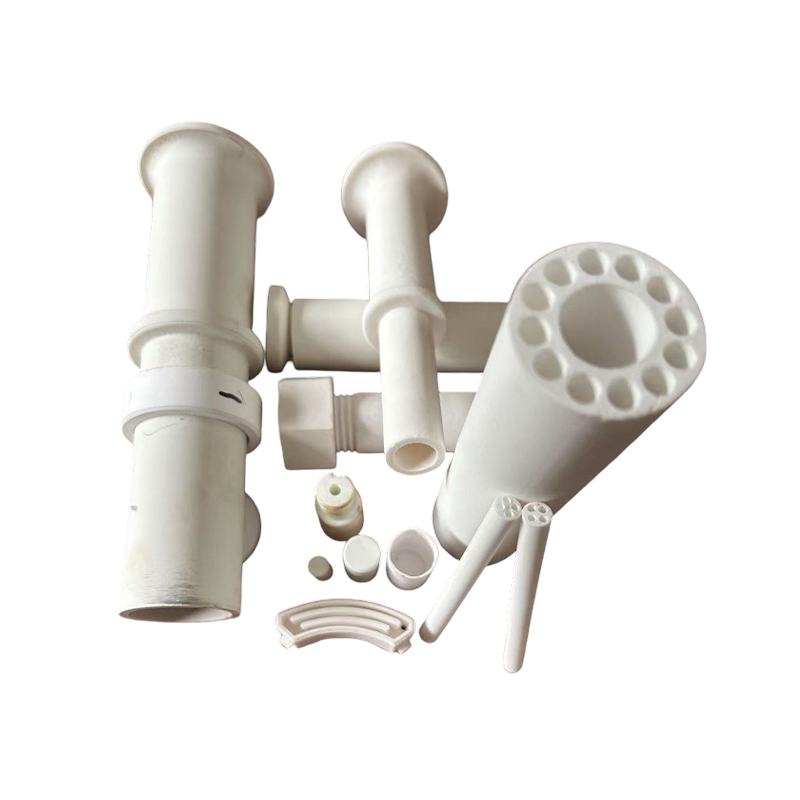What are the breakthrough directions for low-temperature sintering technology in alumina ceramics?
Release Time : 2025-11-12
Due to their high melting point, traditional sintering processes for alumina ceramics require high temperatures to achieve densification. This not only leads to high energy consumption and equipment wear but can also cause abnormal grain growth, weakening the material's mechanical and electrical properties. In recent years, significant progress has been made in low-temperature sintering technology for alumina ceramics, with breakthroughs primarily focused on three areas: raw material modification, process innovation, and additive optimization.
Regarding raw material modification, refining the particle size of alumina powder can significantly reduce the sintering temperature. Nanoscale alumina powders, due to their high surface energy and strong activity, can achieve interparticle migration and bonding at lower temperatures. For example, ultrafine alumina powders prepared by wet chemical methods can reach nanoscale particle sizes, have numerous surface defects, and exhibit significantly better sintering activity than powders prepared by mechanical methods. During sintering, these powders show increased lattice distortion and diffusion rates, which can lower the sintering temperature while simultaneously achieving a microcrystalline high-strength structure. Furthermore, optimization of powder pretreatment processes, such as the sol-gel method, through uniform distribution of metal ions and gelation treatment, can prepare ultrafine powder mixed oxides with higher activity, further promoting the realization of low-temperature sintering.
In the field of process innovation, the development of special sintering technologies has provided new avenues for low-temperature sintering. Hot pressing and hot isostatic pressing, by applying external pressure, promote particle rearrangement and densification, achieving sintering at lower temperatures. Microwave sintering and spark plasma sintering utilize the instantaneous high temperatures generated by electromagnetic fields or plasma to achieve rapid local heating, shortening the sintering cycle and reducing the overall temperature. For example, spark plasma sintering technology, through Joule heating generated by pulsed current and plasma effects, can complete sintering within minutes, with a significantly lower temperature than traditional processes. These technologies not only reduce thermal stress damage to materials but also inhibit grain growth, improving material properties.
Additive optimization is one of the core directions of low-temperature sintering research. Sintering aids, by forming solid solutions or liquid phases with the alumina matrix, significantly reduce the sintering activation energy. Additives that form solid solutions, such as TiO₂ and Fe₂O₃, have lattice constants similar to alumina, which can replace aluminum ions to induce lattice distortion and promote particle diffusion. Among these, additives with variable valence elements enhance lattice activation through changes in electronic structure, further accelerating the sintering process. Additives that generate a liquid phase, such as alkaline earth metal oxides like CaO and MgO, form eutectic compounds at sintering temperatures, promoting mass migration, filling pores, and driving densification through a dissolution-precipitation mechanism. These additives have weak interfacial bonding with the alumina matrix and readily form liquid phases at grain boundaries, significantly improving sintering efficiency.
The development of composite additives is an important trend in additive optimization. Single additives often struggle to simultaneously meet the requirements of low-temperature sintering and performance retention, while composite additives, through synergistic effects, can more comprehensively improve sintering behavior. For example, the CaO-MgO-SiO₂ system, by forming multi-component eutectic compounds, lowers the sintering temperature while refining grains and stabilizing the structure. The introduction of rare earth element additives such as La₂O₃ and Y₂O₃ can suppress grain boundary migration and prevent abnormal grain growth, thereby achieving ceramics with high density and excellent mechanical properties at low temperatures.
Alumina Ceramics' low-temperature sintering technology will delve deeper into the improvement of composite additive systems and the development of novel additives. On the one hand, by optimizing the ratio and synergistic mechanism of existing composite additives, more efficient additive combinations will be sought; on the other hand, the application potential of low-melting-point glass phase additives and rare earth oxides will be explored, leveraging their advantages of low addition amounts and good sintering performance to drive technological breakthroughs. Simultaneously, the deepening of low-temperature sintering kinetic analysis and microstructure-property relationship research will provide theoretical support for additive design and process optimization, helping Alumina Ceramics achieve high-performance and low-cost applications in a wider range of fields.







